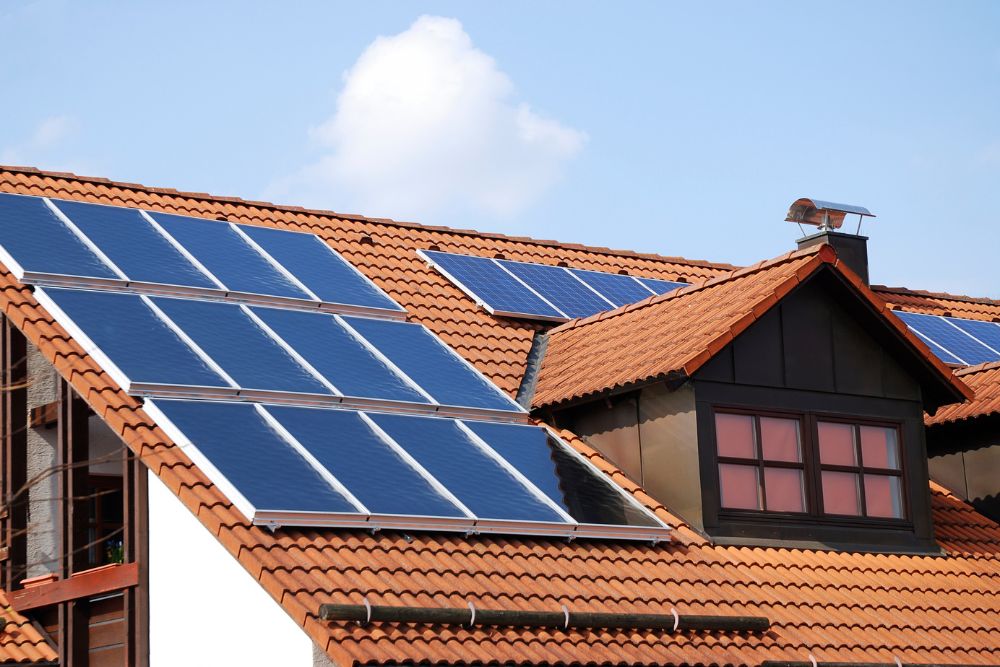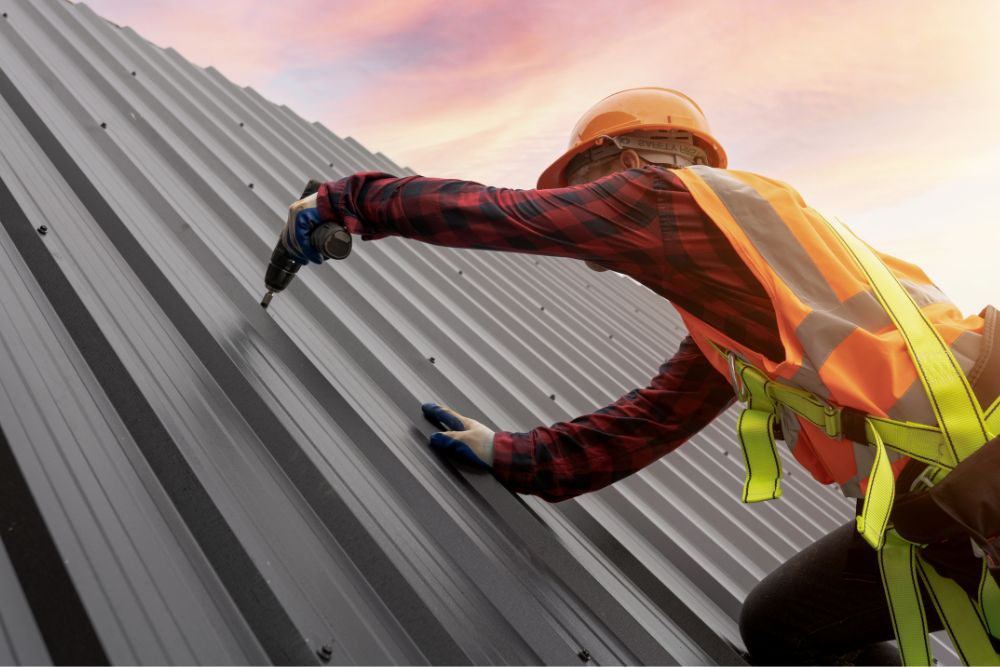Have you ever thought about which roofs work best with solar panels, providing not just shelter but also ideal conditions for generating energy?
The type of roofing material you choose can greatly affect how efficient and long-lasting your solar panel system will be.
When you’re looking at the options available, it’s important to know the specific advantages that different roofing materials offer so you can make a smart choice that matches your goals for sustainability.
Metal Roofing for Solar Panels
Metal roofs are a strong and energy-efficient option for installing solar panels on your house. These roofs can last 40-75+ years, making them a durable choice that can improve solar panel efficiency by reflecting heat. They also qualify for insurance discounts and can increase your home’s value by up to 6%.
Metal roofs have excellent solar reflectance, which helps keep solar panels cool and maximizes energy generation. Opting for a metal roof for your solar panels not only ensures durability and energy efficiency but also adds a touch of sophistication to your home. Make a sustainable decision for your home by choosing a metal roof that enhances both functionality and appearance.
Tile Roofing for Solar Panels
Tile roofs are a strong choice for installing solar panels, lasting for more than a century in different weather conditions. They add a stylish touch to your home while helping with eco-friendly energy generation.
However, it’s important to install the panels carefully because the tiles can be fragile.
Tile Roof Durability
When thinking about how well tile roofs hold up for installing solar panels, it’s important to know they’re tough and can endure different weather conditions. Tile roofs are a smart choice for the long run because they can last for over a hundred years and handle tough weather, making them great for hot areas and by the sea.
When putting solar panels on tile roofs, extra caution is needed because the tiles can break easily, so it’s important to mount the panels securely for the best performance. Even though installing on tile roofs can be tricky, they give a nice look that can improve a property’s appearance with solar panels.
Brackets for solar panels are needed to raise them above the curved surface of tile roofs, ensuring a safe and effective installation process.
Aesthetic Compatibility
Solar panels can enhance the look of your home by seamlessly blending in with tile roofs. Tile roofs are durable and can last for decades, making them a popular choice for solar panel installations, especially in coastal areas and warm climates.
To install solar panels on tile roofs, special brackets may be needed to raise the panels above the delicate tiles. This installation process requires skilled professionals to ensure a secure fit without damaging the roof.
Despite the complexity, combining tile roofs with solar panels not only improves the visual appeal of your home but also provides a reliable and long-lasting solution for sustainable energy generation.
Installation Considerations
When installing solar panels on tile roofs, it’s important to ensure proper mounting and placement for best performance. Tile roofs are durable and great for solar panel installation, especially in hot areas.
Installers in warmer regions have experience working on tile roofs, which helps them do the job well. Sometimes, cutting may be needed for mounts to fit correctly and work efficiently.
It’s crucial to pick skilled installers who know how to work on tile roofs to ensure a successful installation. By choosing the right professionals and ensuring precise placement, you can get the most out of solar energy on tile roofs.
Tar and Gravel Roofing for Solar Panels
Tar and gravel roofs are a great choice for installing solar panels on flat roofs. Here are some key points to consider:
- These roofs work well on flat structures and are cost-effective for solar panel installation.
- For long-lasting results, you’ll need a metal racking system to securely install the panels on tar and gravel roofs.
- Tar and gravel roofs are durable, typically lasting 20 to 25 years, making them a reliable option for solar panel systems.
- You may need additional brackets to tilt the solar panels for optimal energy production on these roofs.
Choosing tar and gravel roofing for solar panels gives you a strong and affordable solution that can meet your solar energy system’s needs effectively.
Wood Shingles for Solar Panels
Wood shingles may not be the ideal choice for solar panels because they’re fragile and pose a fire risk. It’s better to use stronger roofing materials such as metal, asphalt, or tile to support solar panel installations effectively.
When choosing the best option for your solar panels, prioritize the longevity and safety of your roof.
Wood Shingle Benefits
When choosing roofing materials for solar panel installations, it’s important to prioritize safety and durability over looks. While wood shingles may look nice, they aren’t the best option for supporting solar panels. Here’s why:
- Wood shingles can easily break, which can impact the efficiency of solar panels.
- They can be a fire hazard, making them risky for supporting solar panels.
- Using wood shingles for solar panel installation raises safety concerns.
- To ensure the safety and effectiveness of the solar panel system, it’s best to avoid using wood shingles.
Installation Considerations
When considering installing solar panels on a roof with wood shingles, it’s important to note that wood shingles aren’t the best choice due to their fire risk and fragility. Special care is needed during installation to address safety concerns, as wood shingles can be combustible.
Additionally, these roofs have a shorter lifespan compared to other materials, which can affect the performance of solar panels in the long run. To ensure your solar energy system performs well and remains safe, it’s recommended to opt for roofing materials that can support the weight of solar panels and reduce the fire risks associated with wood shingles.
Roof Replacement for Solar Panels
When replacing your roof for solar panels, choose a durable roofing material that lasts as long as or longer than your solar panels. This choice can save you time and money by avoiding the need to remove and reinstall the panels. It also helps maintain the return on investment (ROI) of your solar system and the overall value of your property.
Consider these factors when selecting a roofing material for your solar panel system replacement:
- Cost Impact: The cost of roof replacement can impact your solar system’s ROI and boost your property’s value.
- Increased Home Value: Installing solar panels can increase your home’s value by up to $15,000, making roof replacement a worthwhile investment.
- Durability: Choose a durable roofing material to ensure your solar panel system’s efficiency and longevity.
- Longevity: Opt for a roofing material with a long lifespan to support the durability and effectiveness of your solar panels.
Roof Suitability for Solar Panels
For the best performance and longevity of your solar panel system, choose a roofing material that works well with solar panel installation, such as asphalt, metal, tile, tar, or gravel roofs.
Metal roofs are durable and can last 40-75+ years, offering energy efficiency and heat-reflective properties. Tile roofs, often seen in hot climates, can last over a century.
Tar and gravel roofs are sturdy, energy-efficient, and provide a stable base for solar panel mounts.
It’s best to avoid wood shingles due to their fragility and fire risk, which may not be ideal for solar panel safety and durability. Opt for materials like metal, tile, tar, or gravel when selecting a roof for your solar panels to ensure efficiency and long-lasting performance.
Conclusion
In summary, metal, tile, tar, and gravel roofs are excellent options for solar panels because they’re strong and energy-efficient.
Make sure to pick a roof that can bear the weight of the panels and capture as much sunlight as possible.
By selecting the appropriate roof material and ensuring correct installation, you can enjoy clean, sustainable energy for a long time.



